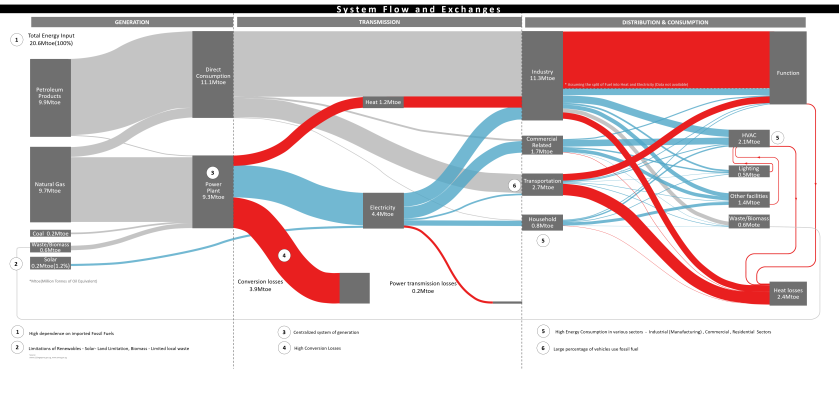
Skyville@Dawson is a 111,106 sq.m., 48-storey1 public housing project by WOHA Architects in Queenstown, Singapore. It is one of two Build-To-Order (BTO) projects commissioned by Singapore’s Housing Development Board (HDB), as part of their “Remaking Our Heartland” initiative (the other being SkyTerrace@Dawson by SCDA Architects)4. This “housing-in-a-park” concept would show transferability in future projects and towns like – Waterway Terraces, Bidadari, Punggol Northshore, Tampines North6. It is the first housing development to be awarded the GreenMark Platinum Rating10. Skyville@Dawson’s Sustainable Design features including Passive Strategies are elaborated below-
Contents
- MASSING AND CONFIGURATION
- Orientation
- Clustering and Modules
- FORM, DAYLIGHT, VENTILATION
- Unit Thickness
- Breathability – Horizontal Air Movement
- Breathability – Vertical Air Movement
- INTEGRATION WITH GREEN AND BLUE
- Horizontal Green
- Site Integration with Green and Blue
- BUILDING ENVELOPE
1) MASSING AND CONFIGURATION
Orientation
(i) The Building is placed with its longer facades facing the North-South9 directions. This reduces exposure to the East and West directions, that are normally difficult to shade.

Clustering and Modules
(i) 8 apartments in plan(as seen in Plan diagrams above), surround a courtyard. This cluster is repeated 2 more times, to create 3 sets of apartments enclosing courtyards. This configuration also provides self-shading, especially from low angle rays from the East and West directions (as seen in the Shadow Studies above).
(ii) In Elevation, 12 clusters form villages, each comprising of 80 apartments.

(iii) The apartment layouts are column and beam free4. This provides the possibility of 3 layouts for residents – reducing wastage, allowing flexibility for multiple functions, family size and the future.
(iv) For standardization, efficiency and to reduce wastage, only 5 window types2 have been used in the entire development.
(v) The design uses precast and prefabricated10 elements to avoid errors and reduce wastage. This feature could also contribute towards LEED BD+C v4 Credit – Construction and Demolition waste management.
2) FORM, DAYLIGHT, VENTILATION
Unit Thickness
(i) The individual apartments are approximately 11 meters across in width, thus applying the Unit Thick Principle. Apartments also have openings in all directions. They are thus naturally ventilated and day lit, reducing artificial cooling and lighting costs.

Breathability – Horizontal Air Movement
(i) The clustering arrangement around courtyards, and the repetition of this module linearly, enables horizontal air circulation.

(ii) Common areas (Lobbies, Corridors, Staircases) and Apartments are naturally ventilated. Many units have not installed Air-conditioning3.
Breathability – Vertical Air Movement
(i) With minimal obstructions and the creation of Canyon like spaces, air moves vertically through the towers – accentuating the breezy atmosphere. The interaction of this air with greenery from sky gardens at intermediate levels, cools this air through evapotranspiration.

3) INTEGRATION WITH GREEN AND BLUE
Horizontal Green
(i) ‘Sky Terraces’7 are located every 12 floors. These are designed as community spaces, where people can collect to interact with neighbors or simply visit to relax and enjoy the lush greenery.

(ii) A ‘Sky Park’7 on the roof has planters, hedges, and beautiful city views. Photovoltaics3 power the common area lighting.
Site Integration with Green and Blue
(i) A 150 m long bio-swale (gently sloping ditch with specific plants) filters and treats site stormwater before discharging it into the city drainage system5. Another example of a bio-swale – water treatment and recycling loop can be seen in Kampung Admirality.

(ii) The site is an ungated3 community, with Public Parks and Amenities that cater to the residents as well as the general public.
4) BUILDING ENVELOPE
(i) Monsoon windows8 on the facade can be kept open during rains, thus providing cool breeze without wind-blown rain entering the home. A similar more advanced Monsoon Window design is utilized in another high-rise residential building – 1 Moulmein Rise, Singapore.
(ii) The walls on the facade have horizontal and vertical sunbreakers5. Balconies or horizontal ledges9 are used to provide shading for openings.
(iii) Double-height verandas10 on the ground level provide pleasant public spaces overlooking the parks.
That’s all for today! We hope you enjoyed this segment. As always, we would love to hear your thoughts, suggestions, queries, opinions.
Thank you!
See you next week.
Credits:
Graphics : Selected graphics are produced as part of a team project for M.Sc. Integrated Sustainable Design at National University of Singapore (Building Semester – Stage 1 – Complex Living Systems). Group Members – Gajender Kumar Sharma, Aditi Bisen, Huang Hongbo, Zhao Yanming
Text: Aditi Bisen
References/ Additional Reading:
- CTBUH. SkyVille @ Dawson – The Skyscraper Center. http://www.skyscrapercenter.com/building/skyville-dawson/14117. Accessed July 18, 2018.
- Furuto A. SkyVille @ Dawson / WOHA. ArchDaily. https://www.archdaily.com/215386/skyville-dawson-woha. Published 2012. Accessed July 18, 2018.
- ArchDaily. SkyVille / WOHA. https://www.archdaily.com/800832/skyville-woha. Published 2017. Accessed July 18, 2018.
- HISTORYSG. SkyVille@Dawson and SkyTerrace@Dawson are launched – Singapore History. http://eresources.nlb.gov.sg/history/events/734a75df-6ece-410f-a1f5-3d0453daf2fe. Published 2015. Accessed July 18, 2018.
- Australian Design Review. An exploration in affordable housing: Skyville @ Dawson. https://www.australiandesignreview.com/architecture/an-exploration-in-affordable-housing-skyville-dawson/. Published 2016. Accessed July 19, 2018.
- Zachariah NA. Dawson’s SkyVille and SkyTerrace projects are raising the bar for stylish public housing. The Straits Times. https://www.straitstimes.com/lifestyle/home-design/dawsons-skyville-and-skyterrace-projects-are-raising-the-bar-for-stylish. Published 2015. Accessed July 19, 2018.
- Willis C. The Skyscraper Museum: GARDEN CITY | MEGA CITY: WOHA rethinks cities for the age of global warming. http://skyscraper.org/EXHIBITIONS/WOHA/skyville.php. Accessed July 24, 2018.
- Pearson CA. SkyVille@Dawson|Gardens in the Sky. Architectural Record. https://www.architecturalrecord.com/articles/7925-skyvilledawson. Published 2013. Accessed July 24, 2018.
- BCA Singapore. BCA GreenMark Buildings Directory | Skyville @ Dawson. https://www.bca.gov.sg/green_mark/KnowledgeResources/BuildingDirectoryDetail.aspx?id=255. Accessed July 26, 2018.
- world-architects. SkyVille @ Dawson WOHA. https://www.world-architects.com/en/woha-singapore/project/skyville-dawson. Accessed July 26, 2018.

